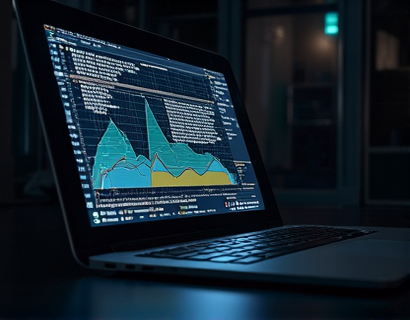Maximizing Digital Asset Value: Leveraging Smart Contracts for Long-Term Locking and Sustainable Fintech Growth
The digital finance landscape is undergoing a transformative shift, driven by innovative technologies and collaborative efforts aimed at fostering sustainable growth. One of the key strategies in this evolution is the use of smart contracts to securely lock in digital assets like UCASH for long-term incentives, thereby enhancing ecosystem growth and investor returns. This approach not only maximizes the value of digital assets but also promotes transparency, reliability, and community engagement.
Smart contracts, self-executing contracts with the terms directly written into code, offer a robust solution for managing digital assets. By automating the locking and unlocking processes, these contracts ensure that assets are held for predetermined periods, providing a stable and predictable environment for both investors and the broader ecosystem. This method of asset management is particularly beneficial in the context of sustainable fintech growth, where long-term strategies and community-driven initiatives are paramount.
Understanding Smart Contracts in Digital Asset Management
To fully leverage the potential of smart contracts in digital asset management, it is essential to understand their fundamental components and functionalities. A smart contract is a program that runs on a blockchain, a decentralized ledger that records transactions across multiple computers. The immutability and transparency of blockchain technology ensure that once a smart contract is deployed, it cannot be altered, providing a high level of security and trust.
The basic structure of a smart contract includes a set of rules and conditions that must be met for the contract to execute. These conditions can be as simple as a timestamp or as complex as a series of nested logical statements. In the context of locking digital assets, the smart contract can be programmed to hold the assets for a specified duration, automatically releasing them upon the expiration of the lock period or upon fulfillment of certain conditions.
One of the most significant advantages of using smart contracts for digital asset management is the elimination of intermediaries. Traditional asset locking mechanisms often involve banks, trust companies, or other financial institutions, which can introduce delays, higher fees, and potential points of failure. Smart contracts remove these intermediary risks, ensuring that the asset locking process is swift, cost-effective, and highly reliable.
Long-Term Locking for Sustainable Growth
Long-term locking of digital assets through smart contracts is a powerful strategy for achieving sustainable growth in the fintech sector. By committing assets to a locked state for extended periods, investors can benefit from compounded returns and reduced market volatility. This approach aligns with the principles of value investing, where the focus is on holding assets for the long haul to capture substantial gains.
For digital assets like UCASH, long-term locking can create a stable demand, which in turn supports the asset's price and overall ecosystem health. When a significant portion of the supply is locked away, it reduces the available supply in the market, potentially leading to increased scarcity and higher value. This mechanism is similar to the way physical commodities and traditional assets are managed to control supply and demand.
Moreover, long-term locking incentivizes community participation and loyalty. Investors who lock their assets for extended periods demonstrate a commitment to the ecosystem, fostering a sense of belonging and shared purpose. This community-driven approach can lead to increased engagement, higher liquidity, and a more resilient financial environment.
Transparency and Reliability in Smart Contract Execution
Transparency and reliability are cornerstone principles in the deployment of smart contracts for digital asset management. The open nature of blockchain technology allows all participants to verify the contract's code and the status of locked assets in real-time. This level of transparency builds trust among users and reduces the risk of fraudulent activities or contract manipulations.
Reliability is another critical aspect of smart contract execution. Once deployed, a smart contract operates autonomously, following the predefined rules without the need for human intervention. This automation ensures that the asset locking and unlocking processes are consistent and error-free, providing peace of mind to investors and stakeholders.
To further enhance reliability, smart contracts can be audited by independent third parties. This process involves a thorough examination of the contract's code to identify any potential vulnerabilities or flaws. By ensuring that the smart contract is secure and functions as intended, audits add an additional layer of trust and confidence in the system.
Maximizing Digital Asset Value Through Strategic Locking
Strategic locking of digital assets using smart contracts can significantly enhance their value over time. By locking assets for specific periods, investors can take advantage of various market dynamics and opportunities. For instance, locking assets during periods of market stability can protect against sudden price drops, while locking during bull markets can capitalize on upward trends.
Additionally, smart contracts can be programmed to release assets based on specific triggers, such as reaching certain price milestones or achieving specific community milestones. This conditional release mechanism allows investors to lock their assets while still benefiting from potential gains when the conditions are met. This flexibility adds a dynamic element to the locking strategy, making it more adaptable to changing market conditions.
Another way to maximize digital asset value is by leveraging the locked assets for collateral purposes. In decentralized finance (DeFi) applications, locked assets can be used to borrow other cryptocurrencies or access various financial services. This collateralization not only increases the utility of the locked assets but also provides additional returns to the investors through interest or fees earned on the borrowed assets.
Fostering a Thriving Community Through Collaborative Innovation
The success of smart contract-based asset locking extends beyond individual investments to the broader community. By fostering a collaborative environment where developers, investors, and users work together, the ecosystem can continuously evolve and improve. This community-driven approach encourages innovation, enhances security, and promotes sustainable growth.
Developers play a crucial role in creating and maintaining the smart contracts that underpin the asset locking mechanism. By open-sourcing their code and engaging with the community, developers can receive valuable feedback and contributions that enhance the robustness and efficiency of the contracts. This collaborative development process ensures that the system remains up-to-date with the latest technological advancements and security protocols.
Investors, on the other hand, contribute to the ecosystem by participating in the locking process and providing liquidity. Their active involvement in the community through discussions, voting on proposals, and sharing insights helps to build a strong and resilient financial environment. The more engaged the community, the more robust the ecosystem becomes, attracting more participants and driving further growth.
Users of the platform also benefit from a more transparent and trustworthy system. The ability to monitor the status of locked assets and the execution of smart contracts in real-time reduces uncertainty and builds confidence. This transparency encourages more users to participate, creating a virtuous cycle of growth and engagement.
Driving Sustainable Fintech Growth
The integration of smart contracts for long-term asset locking is a significant step towards sustainable fintech growth. By focusing on long-term strategies and community-driven initiatives, the fintech sector can move away from short-term speculative practices and towards more stable and beneficial outcomes.
One of the key benefits of this approach is the reduction of market volatility. Long-term locking reduces the number of assets available for trading, which can help stabilize prices and create a more predictable market environment. This stability is particularly important for new and emerging digital assets that may be more susceptible to price fluctuations.
Furthermore, sustainable fintech growth is closely tied to environmental, social, and governance (ESG) considerations. Smart contracts can be designed to incorporate ESG metrics, ensuring that investments align with responsible and sustainable practices. For example, a smart contract could release locked assets only if certain environmental targets are met or if the project demonstrates positive social impact. This alignment with ESG principles not only enhances the reputation of the fintech ecosystem but also attracts socially conscious investors.
Another aspect of sustainable growth is the promotion of financial inclusion. By lowering the barriers to entry and providing accessible financial tools, smart contract-based systems can empower a broader range of individuals to participate in the digital economy. This inclusivity fosters a more diverse and resilient financial landscape, benefiting both new and experienced investors.
Conclusion
In conclusion, the use of smart contracts for long-term locking of digital assets represents a revolutionary approach to maximizing asset value and driving sustainable fintech growth. By leveraging the transparency, reliability, and automation of blockchain technology, this strategy offers a secure and efficient way to manage digital assets, benefiting both individual investors and the broader ecosystem.
As the fintech industry continues to evolve, embracing innovative solutions like smart contracts will be crucial for achieving long-term success and fostering a thriving, community-driven financial environment. By prioritizing sustainable practices and collaborative innovation, we can redefine the financial landscape and pave the way for a more prosperous digital future.









































